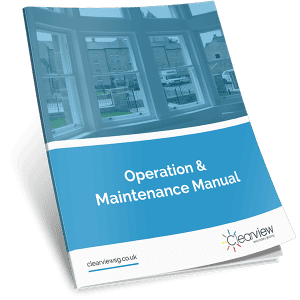Vision Tilt-in balanced vertical sliders
The standard slide arrangements are as per the Standard Balanced Vertical Slider as detailed above. the tilt facility is engaged using the small catches on the top of teach sash. Open the panel slightly, pull the catches left/right towards the button catch, this will release the pons holding the sash in place, the pivot the panel towards you. The panel support arms will extend support the weight until the panel has reached is full tilted position. Lower the top sash and carry out the same process. The bottom panel need to be tilted before the top sash can be tilted. Reverse the process to return the unit to standard sliding mode and make sure the tilt pins are fully engaged. (note, if a panel size is less than 400mm tall, the hinged support stays cannot be applied so the panel will need manual support whilst tilted).
Arched top (tilting) vertical sliding systems
The top sash is not designed to open for ventilation purposes, as the retaining clips cannot bit fitted to hold the panel, into the frame. For cleaning or maintenance, to engage the tilt facility on the top sash: If anti-slide blocks are fitted these can be unscrewed and removed. The top sash can then be lowered in the standard way. IMPORTANT: To prevent damage or injury, the sash must be supported (held back into the frame) when lowering to prevent it falling forward. This would then operate as the systems described above. To close, reverse the process, taking care to lock the panels securely back into position. It is recommended that this be carried out by 2 persons.
Tilt Feature: (old Classic tilting models only)
- It is important to familiarise yourself with this information, as damage or injury can occur if you fail to undertake the process correctly. The tilt feature is only required when cleaning the inner surface of the Secondary glass or to gain access for maintenance or cleaning of areas which cannot be accessed by the standard vertical sliding action. To engage the tilt feature: t
- Unlock swivel fitch catch, lift the sash in the vertical sliding method, so the bottom of the sash slightly clears the bottom of the main frame (circa 2cm). This releases the interlock of the mid rail, and allows the sash to pivot free of the main lower frame.
- Using your forefingers, release the buttons/tilt catches on the other side of the interlocking mid rail (pulling inwards towards the fitch catch), this will release the sash pane from the main frame. Move the frame slightly towards you, the buttons can then be released, the spring clips will then be free of the frame.
- IMPORTANT: once the tilt catches are disengaged from the frame, the pane is free floating and can fall if not supported. Take care at all times during this process to ensure the pane is supported whilst tilted out of the frame.
- Once released, keeping the pane level at all times, carefully and slowly lower to approx. 90 degrees. This can be rested on a stool or chair back etc. The pane needs to be kept level at all times, if it twists it can pull the spring balances out of the frame track mounting.
- The top sash can then be lowered in the standard vertical travel method to its lowest point of travel and the same tilt release method used.
- Note the sashes can’t be removed from the frame completely as they are locked into the spring balances.
- Once the required work is complete the sashes can be returned by reversing the process. Carefully and�� keeping level lift the top pane then the bottom pane back into position. Locking the tilt release catches back into the sides of the main frame.
- VERY IMPORTANT: Ensure the tilt retaining clips are securely locked back into the frame. If these are not securely locked back the sash will potentially be free to fall.
- Subject to the size of the units, the tilt process may require two people.
Lift out units
The sashes can be removed by lifting vertically within the frame until the bottom edge is clear of the frame pivot slightly and then lower the panel free from the frame. It is re-instated by reversing the process. Taking appropriate care when lifting large glass panels. If the lift out has the inclusion of turn-buttons, the lift out panel is obviously held in place by the turn-button. These operate by using a screwdriver to rotate the button by 90-degrees to release the panel, When the panel has been replaced re-set the buckles by reversing the process. Always consider the weight of the panel for safe handling and if more than one person should assist with the process.
Single and double side hung casements
The operating handle is turned 90 degrees to the horizontal position to allow the unit to to open.
For tilt and turn units, rotate the handle a full 180 degrees to engage the tilt mode.
For double hinged units The “secondary sash” of the double casement has a retention bolt fitted at sill level, this needs to be disengaged to open both casements. This must be re-engaged when closing the window to ensure a good seal.
Maintenance
There are no special maintenance requirements other than periodic cleaning as all moving parts are factory sealed with lubricant before assembly. The cleaning cycle will be dictated by local conditions and should consist of washing down the glass and aluminium with non-alkaline detergent in warm water using a cloth or sponge. For more stubborn marks a soft brush or nylon pad should be used. Avoid abrasive cleaners, steel wool, strong acids or alkalis. After cleaning it is advisable to rinse the surfaces with clean water and wipe dry. Chips and scratches in the paint finish can be touched in using non-cellulose paint but care must be taken to prevent paint getting into draught seals or moving parts. Repair of anodised finishes is not practical other than by touching in with a colour-matched paint but the finish appearance is seldom complementary. Bottom tracks of horizontal sliding systems should occasionally be vacuumed to avoid dirt build up and, if necessary, a silicone lubricant can be sprayed onto the track. Clearview offer a full maintenance service outside of our standard 10 year guarantee period. Preventative maintenance contracts are also available upon request.
Cleaning Low-E glass: Take care when cleaning the coated surface, whilst a hard coat application is can be scratched is abrasive materials are used. We recommend using a clean lint free soft cloth, using soap and water or a vinegar based window cleaner, gently clean as normal.



